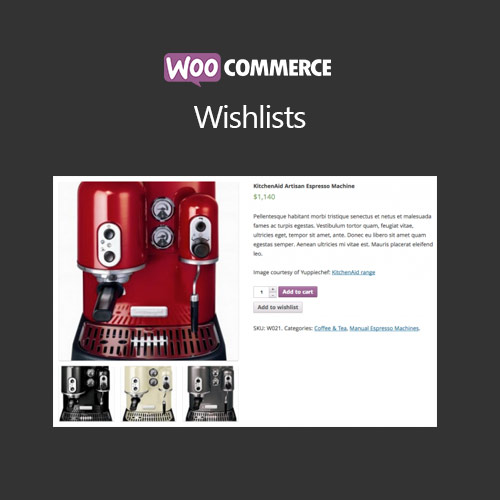Mega Sale: 50% Off On Lifetime Limited Membership. Discount Code: 50OFF | Buy Now.
WooCommerce Wishlists 2.2.5
- Updated on July 1, 2023
- 100% Original Product & Well Documented
- Unlimited Domain Usage
One Time Price:
₹4,500.00 Original price was: ₹4,500.00.₹149.00Current price is: ₹149.00.
- Secured & Scanned by Virus total & McAfee.
- Access to Free updates for Lifetime
- All products are Under GPL License (Unlimited Domain Usage)
- These Products are Pre Activated, You Don’t Need Any license Key to use them.
- 100% Refund Guarantee (Refund Policy)
Buy With Confidence
5 Star Trustpilot Reviews
Lifetime Access
Access 3000+ Premium Products
WooCommerce Wishlists: Boosting Customer Engagement and Sales
Introduction
In the realm of e-commerce, customer engagement is a key driver for increased sales and brand loyalty. One powerful tool that enhances the shopping experience and encourages customer interaction is the WooCommerce Wishlist. In this article, we will delve into the concept of WooCommerce Wishlists, their benefits, and how they can elevate your online store to new heights.
Table of Contents
- Understanding Wishlists
- The Importance of Wishlists in E-Commerce
- Key Features of WooCommerce Wishlists
- Implementing WooCommerce Wishlists on Your Store
- Strategies to Promote Wishlists and Drive Sales
- Analyzing Wishlist Data for Personalization
- Wishlists and Social Sharing
- Integrating Wishlists with Email Marketing Campaigns
- Optimizing Wishlists for Mobile Devices
- Enhancing Customer Experience through Wishlist Notifications
- Measuring Success: Tracking Wishlist Conversion Rates
- Managing Wishlist Abandonment
- Addressing Security and Privacy Concerns
- Leveraging User-Generated Content from Wishlists
- Conclusion
1. Understanding Wishlists
Wishlists are a feature commonly found on e-commerce platforms that allow users to create personalized lists of products they desire. These lists serve as reminders, allowing customers to save items for future reference or purchase.
2. The Importance of Wishlists in E-Commerce
Wishlists play a vital role in enhancing customer engagement and boosting sales. They provide several benefits, including:
- Increased customer satisfaction: Wishlists enable customers to curate a collection of their preferred products, improving their overall shopping experience.
- Improved conversion rates: By allowing users to save items for later, wishlists reduce the likelihood of cart abandonment and provide opportunities for follow-up marketing.
- Enhanced product discovery: Wishlists serve as a discovery tool, helping customers explore and find products they may have missed during their initial browsing.
- Social proof and recommendations: Wishlist data can be leveraged to provide personalized product recommendations and showcase popular items, reinforcing customer trust and driving sales.
- Insights into customer preferences: Wishlist analytics offer valuable insights into customer preferences and trends, enabling businesses to make data-driven decisions for product offerings and promotions.
3. Key Features of WooCommerce Wishlists
WooCommerce Wishlists offer a range of features designed to enhance the customer experience and drive conversions:
- User-friendly interface: WooCommerce Wishlists are easy to navigate, allowing customers to effortlessly add and manage their desired products.
- Privacy settings: Users can choose to keep their wishlists private or share them with others, facilitating social sharing and collaboration.
- Multiple wishlists: WooCommerce allows users to create multiple wishlists, such as “Birthday Wishlist” or “Holiday Wishlist,” catering to different occasions and personal preferences.
- Product variations: Wishlists can accommodate product variations like sizes, colors, or styles, allowing customers to save their specific choices.
- Quantity and priority: Users can specify the quantity and priority of each item on their wishlist, aiding in decision-making and allowing businesses to understand customer preferences.
4. Implementing WooCommerce Wishlists on Your Store
Adding WooCommerce Wishlists to your online store is a straightforward process. Follow these steps:
- Install the WooCommerce plugin on your WordPress website.
- Navigate to the plugin settings and enable the “Wishlist” feature.
- Customize the wishlist settings according to your preferences, such as privacy options and button placements.
- Configure email notifications to keep customers informed about wishlist updates and promotions.
5. Strategies to Promote Wishlists and Drive Sales
To maximize the benefits of WooCommerce Wishlists, consider implementing these strategies:
- Prominent placement: Position the wishlist button prominently on product pages, making it easily accessible to customers.
- Incentives and rewards: Offer exclusive discounts, rewards, or freebies to customers who create wishlists or share them with others.
- Social sharing buttons: Incorporate social media sharing buttons to encourage customers to share their wishlists with friends and family.
- Email marketing campaigns: Send personalized emails reminding customers about their wishlists and offering tailored promotions.
- Cross-selling and upselling: Recommend related or complementary products to customers based on their wishlist items, encouraging additional purchases.
6. Analyzing Wishlist Data for Personalization
Wishlist data provides valuable insights into customer preferences and interests. Leverage this data to personalize the shopping experience by:
- Recommending similar or related products based on wishlist items.
- Sending personalized emails with tailored offers and promotions.
- Creating targeted advertising campaigns based on customer preferences.
7. Wishlists and Social Sharing
Social sharing is a powerful way to amplify the reach and impact of wishlists. Enable social sharing options, allowing customers to showcase their wishlists on platforms like Facebook, Instagram, or Pinterest. This generates social proof and facilitates organic promotion of your products.
8. Integrating Wishlists with Email Marketing Campaigns
Email marketing remains a highly effective channel for engaging customers. Incorporate wishlists into your email marketing campaigns by sending automated emails reminding customers about their saved items and providing personalized recommendations based on their wishlist history.
9. Optimizing Wishlists for Mobile Devices
With the increasing use of smartphones for online shopping, it is crucial to ensure that wishlists are optimized for mobile devices. Implement responsive design techniques, streamline the user interface, and make it easy for customers to add items to their wishlists with a single tap.
10. Enhancing Customer Experience through Wishlist Notifications
Keep customers engaged and informed about their wishlists by enabling real-time notifications. Notify customers about price drops, stock availability, or limited-time offers on their desired products. This fosters a sense of urgency and encourages prompt action.
11. Measuring Success: Tracking Wishlist Conversion Rates
To evaluate the effectiveness of your wishlist strategy, track and analyze wishlist conversion rates. Monitor metrics such as the number of wishlist items converted into purchases, revenue generated from wishlists, and customer engagement levels. Use this data to refine your marketing efforts and optimize the shopping experience.
12. Managing Wishlist Abandonment
Wishlist abandonment can occur when customers add items to their wishlist but do not proceed with the purchase. Address this issue by implementing targeted remarketing campaigns, offering incentives, and providing seamless pathways for wishlist items to be added to the shopping cart.
13. Addressing Security and Privacy Concerns
Ensure the security and privacy of customer wishlists by implementing robust data protection measures. Clearly communicate your data handling practices and adhere to relevant privacy regulations. Additionally, provide customers with the option to control the visibility of their wishlists.
14. Leveraging User-Generated Content from Wishlists
User-generated content (UGC) can be a powerful tool for marketing. Encourage customers to share their wishlist experiences by featuring customer testimonials, reviews, or social media posts showcasing their favorite wishlist items. This not only builds trust but also serves as valuable social proof for prospective customers.
15. Conclusion
WooCommerce Wishlists are a valuable feature that can greatly enhance your e-commerce store. By providing customers with a personalized and interactive shopping experience, wishlists boost customer engagement, increase conversions, and improve brand loyalty. Implement the strategies outlined in this article to leverage the full potential of WooCommerce Wishlists and unlock new avenues for growth in your online business.
Important notice!
How to Download After Purchase visit this page:- How to
After the Download File Extract the Zip or RAR File And Only Upload the Main File Of the Theme & Plugin
👉 Our Support is Limited to Installation. (Theme Demo & Template is Not part of our support)
👉 We do Not Provide any License Key. Don’t Ask For a License Key.
👉 Need Any support Raise ticket on Live chat.
 WooCommerce Wishlists 2.2.5
WooCommerce Wishlists 2.2.5
Products you Like

Savoy 2.9.3 – Minimalist AJAX WooCommerce Theme

Saasland 3.6.5 – MultiPurpose WordPress Theme for Startup

Salient 16.2.2 – Responsive Multi-Purpose Theme





Reviews
There are no reviews yet